In this article you will find the brown algae examples and their detailed facts.
Brown algae of class Phaeophyceae are multicellular eukaryotic algae rich in phycocolloid and fucoxanthin which posses chlorophyll c, 3-thylakoid lamellae and food reserve unit called laminarin.
List of Brown algae examples
- Ectocarpus
- Alaria
- Dictyota
- Nereocystis
- Padina
- Laminaria
- Sargassum
- Fucus
- Durvillaea
- Pelvetia
- Ascophyllum
- Sphacelaria
Ectocarpus
It is filamentous algae and can grow upto 30cm. There are mostly marine but some are also fresh water. It shows cosmopolitan distribution like colder areas or polar regions. Species of ectocarpus are mostly littoral and supralittoral. Most of the species are lithophytic but some are epiphytic (E.coniferous & E.breviarticularis grow on other brown algae thallus) and some are endophytes ( E.dermonematics which grow inside the other algae).
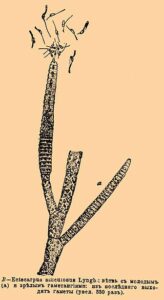
Alaria
It is a large brown seaweed algae of class phaeophyceae and are mainly eaten as food in many countries like china, korea and japan. They can grow upto 2m in length. Example : Alaria esculenta is an example of edible seaweed.
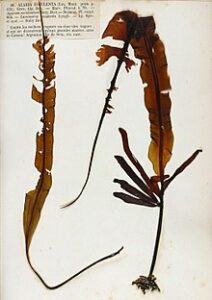
Dictyota
It is a salt water algae. The thallus is unique and has mat like appearance. They are widely spread in warm seas of tropic, most of the time they are attached with rocks of the basal holdfast. Thallus is plant body which is a strap like structure which can grow between 10-20cm in length and are repeatedly branched and each of branch is further divided into two branch(dictyota) and keep dividing. Every tip of the branch have an apical cell and these cells decides the growth of the thallus.
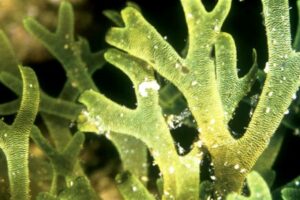
Nereocystis
They are commonly called bull kelps mainly found on the beach of Pacific coast. They are easy to identify having large spherical bulb at the end and long stalk. They die once in a year especially in winters.
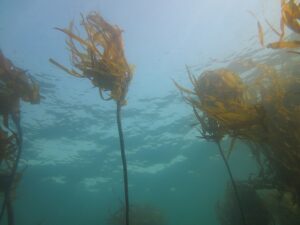
Padina
Padina has flattened, erect, fan-shaped thallus and rolled apical margin. It has the capacity to incorporate calcium into their thallus. Its common name are Mermaid’s fan seaweed, Peacock’s tail, turkey feather algae and white scroll alga. Another feature is they are slow growing and complex in nature. Pedina has 27 species found globally.Examples: Pedina pavonica (Peacock’s tail), P.gymnospora, P.adanson etc. Habitat is obviously marine and coastal region.
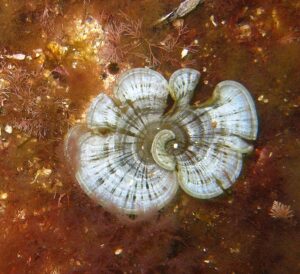
Laminaria
It is marine brown alga having length of 2m. Body is divided into lamina, stipe and holdfast. Lamina can be single (L.saccharina) or having many segments(L.digitate). Reproduction can be done by vegetative, sexual and asexual means. Vegetative reproduction can be done by arising stolon from holdfast. Asexual reproduction is done by developing zoospores and sexual reproduction is completely external antherozoids and eggs are released outside the body.
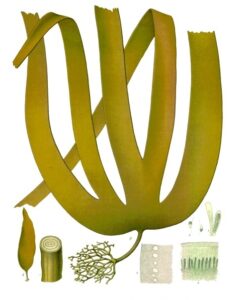
Sargassum
They are mainly found in the atlantic ocean having a region called “Sargasso sea”. They are branched, sporophytic, body is differentiated into main axis and holdfast. Main axis differentiated into many primary laterals and these laterals bears leaves. Surface of leaves has many pores called ostioles. Growth is done by using apical cells. Reproduction is done by two modes: Vegetative and Sexual. Vegetative is usually takes place by fragmentation while sexual reproduction is external. They contain flask-shaped cavity called conceptacles where sex organs are produced.
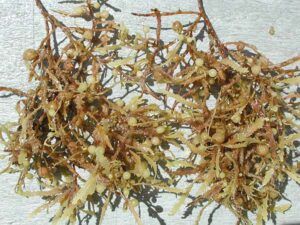
Fucus
It is also marine brown alga. There are about 100 species found worldwide but there is no species of the fucus found in India. Plant body is well branched, divided into frond, short stipe and holdfast which helps them to attach to the substratum. Air bladders are found in some species like F.vesiculosus. The terminal part of branch has fertile receptacle and frond surface contain number of pores called cryptostomata or cryptoblast.Again reproduction occurs by two modes: Vegetative and sexual. Vegetative occurs by fragmentation or by adventitious branches and sexual reproduction is done by external fertilization. F.spiralis is monoecious while F.vesiculosus is dioecious in nature
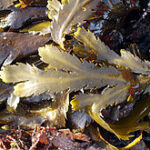
Durvillaea
Durvillaea antartica is one of the massive brown algae found at different coast of Australia. Many species D.poha and D.antartica shows buoyancy due to honey-comb like structure in their fronds. They have been using as tool, clothing and a food source in many regions of south pacific.
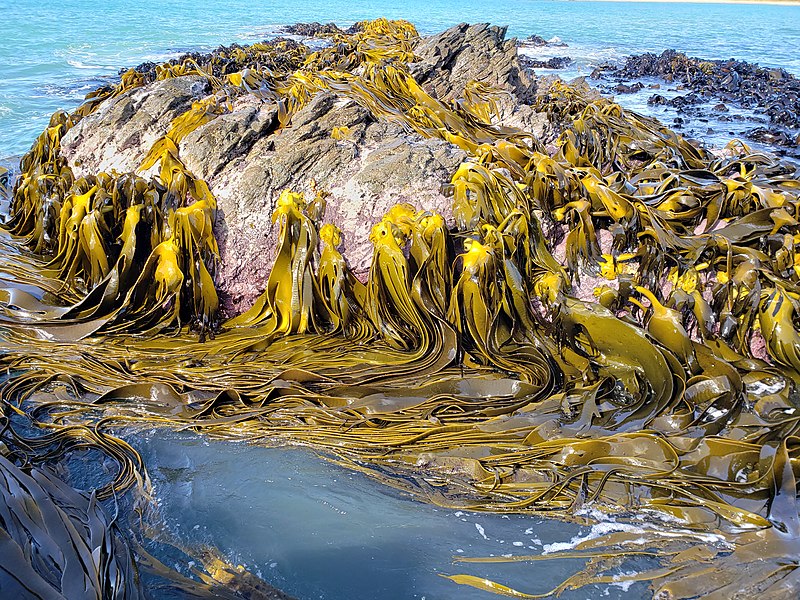
Pelvetia
They are very common brown algae generally found at the littoral regions of Europe. They grows upto 15cm in dense tufts having receptacle at terminal branch. Mucus layer is present to prevent desiccation when there is no tide. Example: Pelvetia canaliculata.
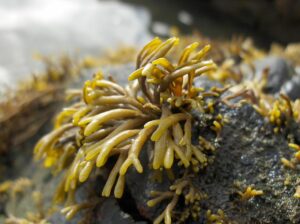
Ascophyllum
Ascophyllum nodosum is one of the large algae found that generally grows in the north altantic ocean. It has long and tough fronds having egg shaped air bladder at regular intervals. This algae is harvested for many purposes like fertilizers, alginates and seaweed meal for animals and for human consumption also. It has many benefits as it provides heat tolerance so that animals can work harder and longer in hot weather without getting overheated.
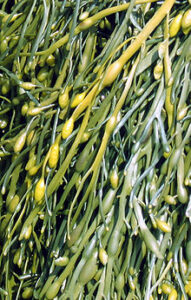
Sphacelaria
They have big apical cell at terminal branch which play major role in mitosis and helps in increasing the length of the plant as well as of the branches. The girth of the pluriseriate filament is accomplished through parenchymatous development. They have plurilocular and unilocular sporangium that form the asexual reproductive cycle. Vegetative reproduction is done by using propagules.
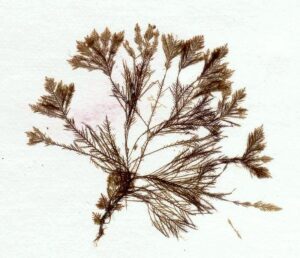
Frequently Asked Questions
Q1. Define thallus.
Thallus is a somatic plant body like structure which do not have true stem, leaves and roots.
Q2. What is food reserve of phaeophyta?
Laminarin and Mannitol
Q3. What are fronds?
Leaves like structures are called fronds.
Q4. Define fucoxanthin.
Brown algae develops their colour due to presence of abundant brown colour pigment xanthophyll called fucoxanthin.
Q5. What is Phycocolloids?
Brown algae have two types of nonsulphurated phycocolloids: algin and fucoidin. This will protect the algae from dessication during winters and low tides.
Q6. Give algin uses.
It is a phycocolloid obtained from various species of Phaeophyta like fucus, laminaria etc. They are used as emulsifiers and thickeners and gelating agents in number of products like tooth paste, shaving creams, cosmetics, paints and shampoo.
Q7. What are Phaeoplast?
Plastids of brown algae are called phaeoplasts. Each photosynthetic plastid is connected to endoplasmic reticulum and form the complex called CER (chromatophore endoplasmic reticulum).
Q8. What is the minimum and maximum size of the brown algae?
It varies from 1mm to 60m. The larger forms of brown algae are called giant kelps. Example : Ectocarpus filifer has small size of around 1mm and while largest size is about 60m of Macrocystis pyrifera. Laminaria is a small kelp of size 2-3m.
Also Read:
- Antiparallel dna strands 2
- Centipede examples
- Are bacteria negatively charged
- Are protists aquatic
- When does the cytoplasm divide
- Cytosol and cytoplasm
- Anticodon sequence
- Do protists have a cell wall
- Dna transcription enzyme
- Is independent assortment mutation

Hi, I am Saif Ali. I obtained my Master’s degree in Microbiology and have one year of research experience in water microbiology from National Institute of Hydrology, Roorkee. Antibiotic resistant microorganisms and soil bacteria, particularly PGPR, are my areas of interest and expertise. Currently, I’m focused on developing antibiotic alternatives. I’m always trying to discover new things from my surroundings. My goal is to provide readers with easy-to-understand microbiology articles.
If you have a bug, treat it with caution and avoid using antibiotics to combat SUPERBUGS.
Let’s connect via LinkedIn: